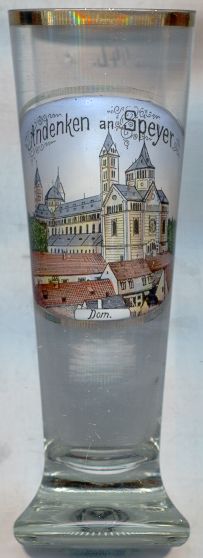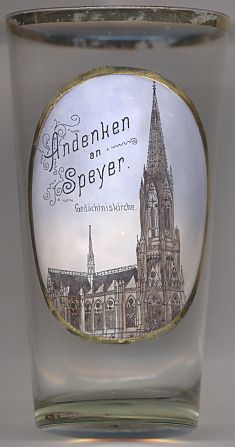

|
| DEUTSCHLAND | GERMANY |
| Bundesland: Rheinland-Pfalz | Rhineland-Palatinate |
| Stadt: Speyer |
 Speyer is situated at an elevation of 95 m on the left bank of the river Rhine, about 20 km south of
Ludwigshafen am Rhein and 34 km north of Karlsruhe. The independent city has
a population of about 50,700 (2020).
Speyer is situated at an elevation of 95 m on the left bank of the river Rhine, about 20 km south of
Ludwigshafen am Rhein and 34 km north of Karlsruhe. The independent city has
a population of about 50,700 (2020).
The area was inhabited already in Celtic times. The Romans founded a military post around 10 BC. The place, named Noviomagus and later Civitas Nemetum, soon became an important centre of the regional administration. During the 6th century, the name Spira appears for the first time in documents. During the 11th and 12th centuries, Speyer became one of the main centres of the Holy Roman Empire. In 1294 it obtained the status of a free Imperial town. A total of 50 Imperial diets, among them such important ones as those of 1526 and 1529, took place here. After the Peace of Lunéville in 1801, Speyer became part of France and was the seat of a sous-préfecture within the département Mont-Tonnerre (Donnersberg; capital at Mainz / Mayence). After the Congress of Vienna (1815) Speyer became part of the Kingdom of Bavaria in 1816 and was the seat of the administration of the Bavarian Palatinate until 1937. In 1945 it became part of the newly formed state of Rheinland-Pfalz (Rhineland-Palatinate). The cathedral was declared a World Cultural Heritage by the UNESCO in 1981. The medieval jewry-court, with the stuctures of the synagogue and the women's shul (synagogue), the archaeological vestiges of the yeshiva (religious school), the courtyard and the still intact underground mikveh (ritual bath) were inscribed in that list in 2021 (together with the jewish sites of Mainz and Worms). (see also list of other UNESCO heritage sites depicted on glasses of this collection)
The famous  Kaiserdom (Imperial cathedral) Sankt Maria und Sankt Stephan [left, no. 1418]
was founded by Emperor Konrad II in 1030 and was consecrated in 1061. After a large fire in 1689 the church was reconstructed in 1758–1778.
The impressive western façade was built in 1854–1858 in Neo-Romanesque style. The crypt contains the tombs of four emperors
(Konrad II, d.1039; Heinrich III, d.1056; Heinrich IV, d.1106; and Heinrich V, d.1125) and four German kings
(Philipp of Swabia, d.1208; Rudolf I of Habsburg, d.1291; Adolf of Nassau, d.1298; and Albrecht I of Habsburg, d.1308).
In 1925 the church received the papal title of a Basilica minor.
(see also list of other basilicae minores depicted on glasses of this collection)
Kaiserdom (Imperial cathedral) Sankt Maria und Sankt Stephan [left, no. 1418]
was founded by Emperor Konrad II in 1030 and was consecrated in 1061. After a large fire in 1689 the church was reconstructed in 1758–1778.
The impressive western façade was built in 1854–1858 in Neo-Romanesque style. The crypt contains the tombs of four emperors
(Konrad II, d.1039; Heinrich III, d.1056; Heinrich IV, d.1106; and Heinrich V, d.1125) and four German kings
(Philipp of Swabia, d.1208; Rudolf I of Habsburg, d.1291; Adolf of Nassau, d.1298; and Albrecht I of Habsburg, d.1308).
In 1925 the church received the papal title of a Basilica minor.
(see also list of other basilicae minores depicted on glasses of this collection)

The Protestant  Gedächtniskirche (Memorial Church) [near left, no. 2102] was built in 1893–1904 as a memorial to the
"Protestation" of the Protestant states at the Imperial Diet of 1529. The design in Gothic revival style was made by the architects Julius Flügge and Carl Nordmann from
Essen who had won the competition of 1883. The interior decorations of the church date from the time of its construction.
Gedächtniskirche (Memorial Church) [near left, no. 2102] was built in 1893–1904 as a memorial to the
"Protestation" of the Protestant states at the Imperial Diet of 1529. The design in Gothic revival style was made by the architects Julius Flügge and Carl Nordmann from
Essen who had won the competition of 1883. The interior decorations of the church date from the time of its construction.
[https://de.wikipedia.org/wiki/Speyer]
![[scale]](lineal.jpg)